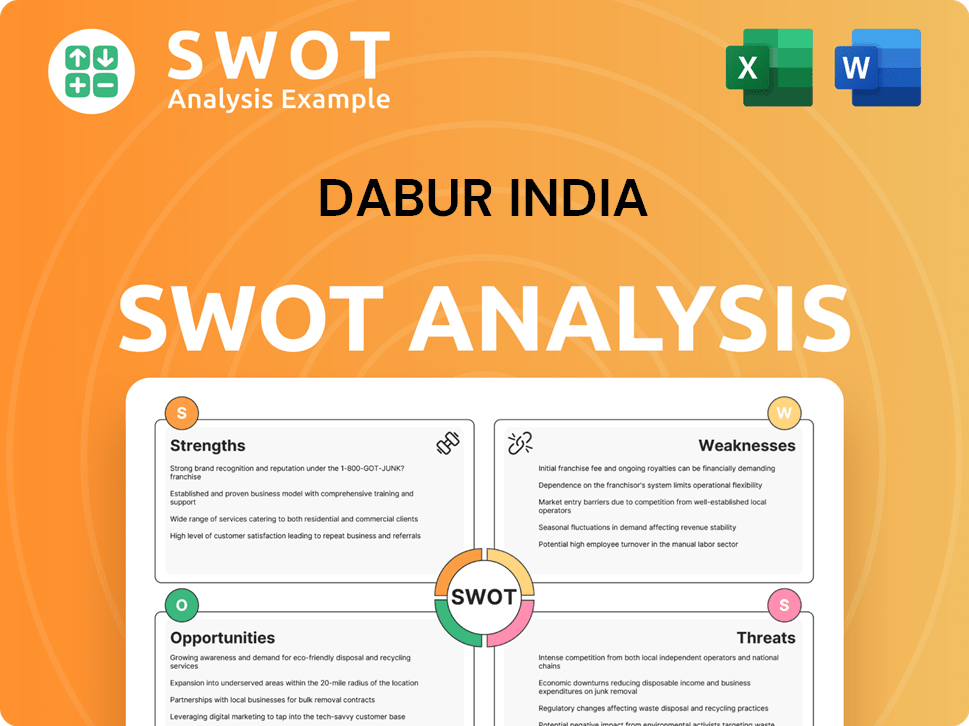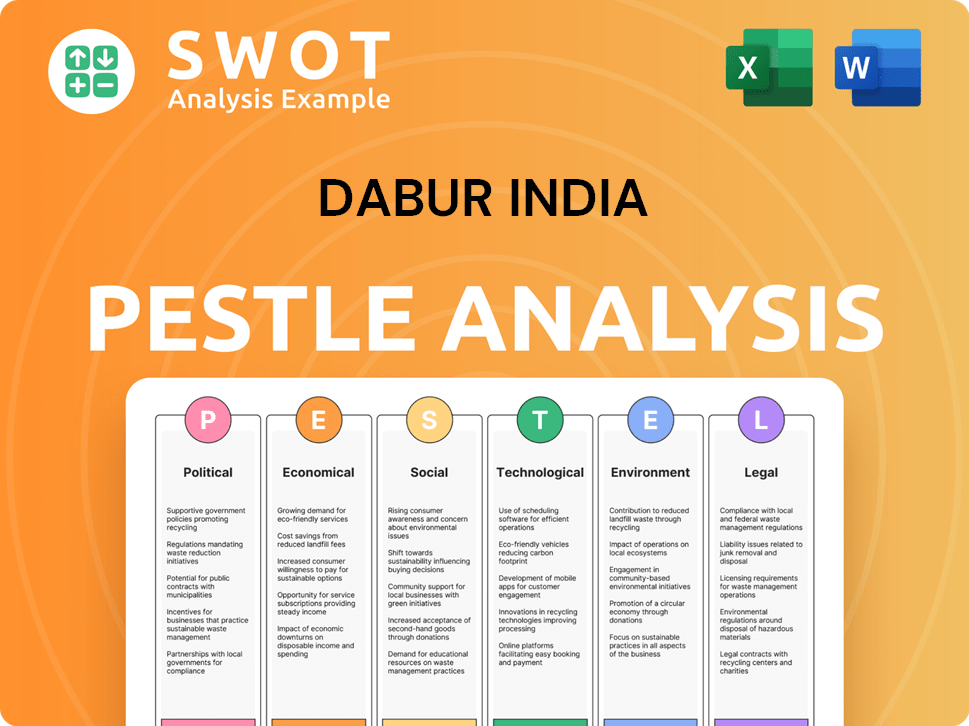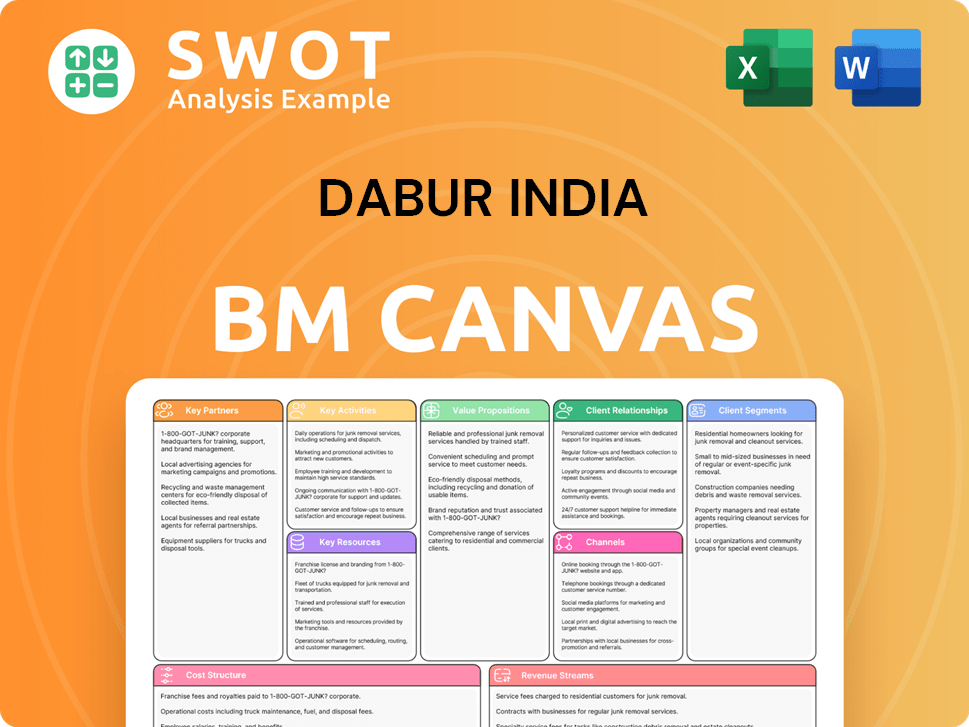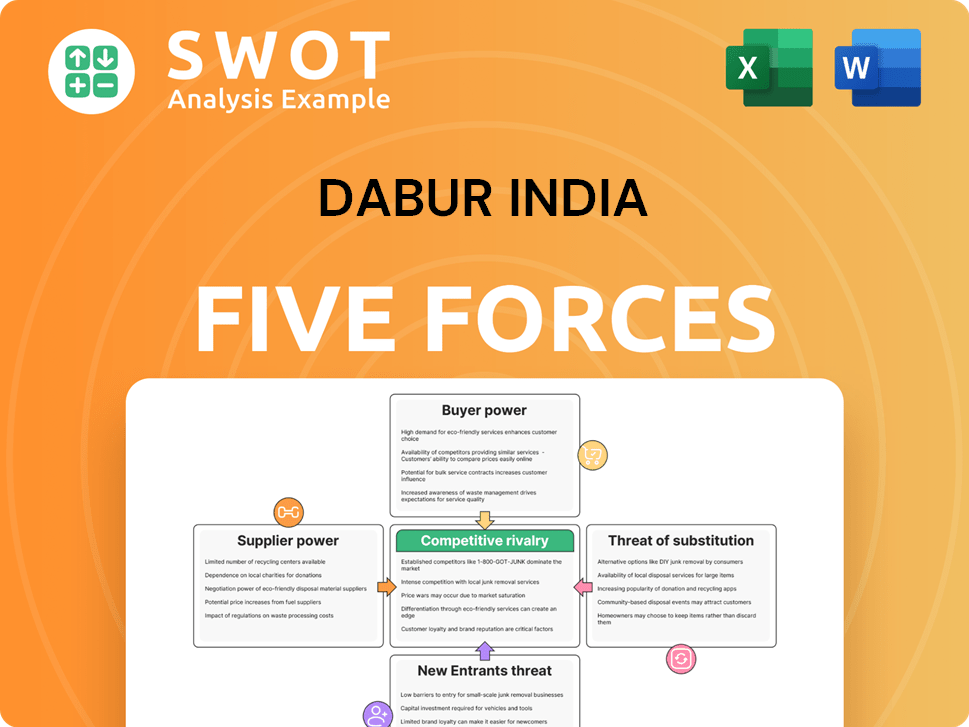Dabur India Bundle
How Does Dabur India Thrive in the FMCG Market?
Dabur India, a titan in the Indian FMCG sector, boasts a rich heritage and a vast product portfolio. With roots in Ayurveda and a legacy spanning over 135 years, Dabur has cultivated a strong brand reputation. This exploration dives into the operational strategies that have propelled Dabur to become a leading player, offering insights into its enduring success.

Dabur's impressive financial performance, with a reported revenue of ₹12,563 crore in FY2024-25, underscores its robust Dabur India SWOT Analysis. Understanding the Dabur business model, including its manufacturing process and extensive distribution network reaching over 7.9 million retail outlets, is key to appreciating its market dominance. This analysis will also examine Dabur's marketing strategy, Dabur products, and how it navigates the competitive Indian FMCG landscape, including its key competitors.
What Are the Key Operations Driving Dabur India’s Success?
The core operations of the Dabur India company center on creating and delivering value through its wide array of Ayurvedic and natural healthcare, personal care, and food products. The Dabur business model relies on a diverse product portfolio exceeding 250 offerings, catering to various customer needs across different segments. Key product categories include health supplements, oral care, hair care, and food and beverages.
These offerings are supported by robust and strategically managed operational processes. The company operates a manufacturing network spanning 9 countries, with 14 facilities in India alone. This ensures a global reach to over 120 countries. The supply chain is responsible for planning, sourcing, and timely delivery of over 3.30 lakh tonnes of raw and packaging material and more than 67 million cases of finished goods annually. The company also collaborates with over 77 contract manufacturers.
A significant aspect of Dabur India's operations is its extensive distribution network, which covers over 7.9 million retail outlets and reaches 122,500 villages as of FY24, with plans to expand to approximately 130,000 villages by FY25. Direct access extends to 1.42 million outlets. This widespread availability, combined with a focus on premiumization and innovation, differentiates the company in the market.
The company's product portfolio includes health supplements (e.g., Dabur Chyawanprash, Dabur Glucose), oral care (e.g., Dabur Red Paste), hair care (e.g., Dabur Amla, Vatika), and food and beverages (e.g., Dabur Honey, Real juices, Homemade, Badshah).
The company operates manufacturing facilities across nine countries, with a vast distribution network covering millions of retail outlets. The company's supply chain handles significant volumes of raw materials and finished goods, ensuring products reach consumers efficiently.
Dabur has embraced digital transformation, becoming the first Indian FMCG Cloud-Only Enterprise in FY2023-24. E-commerce now contributes 10% to the company's sales, with quick commerce emerging as the fastest-growing sub-channel.
The company is enhancing its rural portfolio by introducing new, affordable, and rural-specific product packs to drive demand. Digital-first brands collectively generated over ₹1 billion in turnover in FY24.
Dabur's operations are unique due to its strong healthcare portfolio, providing a competitive edge. The company's focus on digital transformation and e-commerce has significantly boosted sales. Furthermore, the company is expanding its rural reach through tailored product offerings.
- Extensive distribution network reaching millions of outlets and over 122,500 villages.
- Strong healthcare portfolio offering a competitive advantage.
- Digital transformation with e-commerce contributing significantly to sales.
- Focus on rural markets with new, affordable product packs.
For a deeper dive into the company's strategic approach, consider reading about the Growth Strategy of Dabur India.
Dabur India SWOT Analysis
- Complete SWOT Breakdown
- Fully Customizable
- Editable in Excel & Word
- Professional Formatting
- Investor-Ready Format

How Does Dabur India Make Money?
The Dabur India company generates revenue through the sale of its wide range of consumer goods, with diversified streams across healthcare, personal care, and food and beverages. The Dabur business model focuses on leveraging its strong brand presence and distribution network to capture market share across various product categories. For the full financial year 2024-25, Dabur reported a consolidated revenue of ₹12,563 crore, a slight increase from the previous year's ₹12,404 crore.
In the fourth quarter of FY25, the consolidated revenue from operations was ₹2,830.14 crore. The company's monetization strategies include premiumization, mix optimization, and targeted investments in high-potential categories. Dabur also implements judicious price increases to mitigate inflationary pressures, ensuring profitability while maintaining its market position. Understanding the Competitors Landscape of Dabur India is crucial for assessing its market dynamics.
Emerging channels like e-commerce and quick commerce are also significant, contributing approximately 25% to overall sales, with e-commerce alone accounting for 10%. The company's digital-first brands generated over ₹1 billion in turnover in FY24. The healthcare business is a significant contributor, accounting for 31.4% of Dabur's India business in FY24.
The healthcare segment, encompassing health supplements, digestives, OTC, and Ayurvedic ethical products, is a significant revenue driver. Health supplements, particularly Dabur Glucose, have performed well, gaining market share.
The digestives category, led by the Hajmola franchise and Pudin Hara, is also gaining traction. Dabur anticipates its health juices to contribute ₹500 million to revenue in FY25.
The oral care segment posted double-digit value growth in the last quarter and high single-digit volume growth over the past two years. This was driven by market share gains in the natural segment and expansion into non-herbal categories.
The food category, including the Homemade and Badshah brands, has shown robust performance. The company has a strategic target to generate ₹6-7 billion revenue from Badshah over the next three years.
Emerging channels are also significant, contributing approximately 25% to overall sales, with e-commerce alone accounting for 10%. Dabur's digital-first brands generated over ₹1 billion in turnover in FY24.
Dabur's monetization strategies include premiumization, mix optimization, and targeted investments in high-potential categories. The company also implements judicious price increases to mitigate inflationary pressures.
Dabur India PESTLE Analysis
- Covers All 6 PESTLE Categories
- No Research Needed – Save Hours of Work
- Built by Experts, Trusted by Consultants
- Instant Download, Ready to Use
- 100% Editable, Fully Customizable

Which Strategic Decisions Have Shaped Dabur India’s Business Model?
Dabur India, a prominent player in the Indian FMCG sector, has consistently evolved through strategic initiatives and key milestones. The company's growth trajectory is marked by significant expansions and adaptations to market dynamics. Recent developments highlight its commitment to strengthening its market presence and operational efficiency.
A significant achievement is the expansion of its sales network, adding 200,000 outlets in FY24. This expansion, the largest by any FMCG company in India, brings its total reach to over 7.9 million retail outlets and 122,000 villages. Dabur India also aims to reach 130,000 villages by the end of FY2024-25. Moreover, Dabur completed a major cloud migration in FY2023-24, becoming the first Indian FMCG company to operate entirely on the cloud, enhancing business resilience and IT control.
Despite facing challenges like subdued urban demand and fluctuating commodity costs, Dabur India has maintained a strong focus on its competitive edge. This is achieved through brand building, product diversification, and an extensive distribution network. The company's approach includes strategic exits from underperforming categories and investments in core brands, ensuring sustainable growth and market leadership. For more insights, explore the Target Market of Dabur India.
Dabur India's recent milestones include a significant expansion of its sales network, adding 200,000 outlets in FY24. The company also completed a major cloud migration, becoming the first Indian FMCG Cloud-Only Enterprise. These moves highlight Dabur's commitment to growth and operational efficiency.
Dabur India's strategic moves involve strengthening its competitive position through a diverse product portfolio and extensive distribution. The company is focusing on premiumization and expanding into emerging health and wellness categories. This includes introducing modern formats for health supplements and expanding into new segments in oral care.
Dabur India's competitive advantages include a strong brand equity built over 135 years and a diverse product portfolio of over 250 products. The company's healthcare portfolio is expected to see high single-digit growth. Dabur is also aggressive in the value-added hair oil category and has regained market share.
Dabur India plans to focus on premiumizing categories like serums, conditioners, and shampoos in hair care. The company is also making 'bold bets' in health and wellness and expanding into quick commerce. Dabur has announced a strategic exit from several non-performing product categories to accelerate profitable growth.
Dabur India's marketing strategy focuses on adapting to new trends and competitive threats by investing in core brands and expanding into emerging health and wellness categories. The company is also focusing on premiumization across various product lines.
- Investment in core brands to maintain market share.
- Focus on premiumization to increase profitability.
- Expansion into health and wellness categories to meet consumer demand.
- Strategic exits from non-performing product categories.
Dabur India Business Model Canvas
- Complete 9-Block Business Model Canvas
- Effortlessly Communicate Your Business Strategy
- Investor-Ready BMC Format
- 100% Editable and Customizable
- Clear and Structured Layout

How Is Dabur India Positioning Itself for Continued Success?
Dabur India holds a significant position within the Indian FMCG sector, securing its place as the fourth-largest company. The Owners & Shareholders of Dabur India have consistently seen market share gains across a large portion of the product portfolio. This strong market presence is built on a foundation of diverse product offerings and extensive distribution networks.
Despite its robust market position, Dabur faces several risks. These include challenges such as subdued consumer demand and high food inflation. Competition from larger FMCG players and potential supply chain disruptions also pose significant challenges. These factors can impact the company's financial performance and growth trajectory.
Dabur India is a leading player in the Indian FMCG sector. The company has shown consistent market share gains. Its direct reach extends to over 1.42 million retail outlets.
Key risks include subdued consumer demand, especially in urban areas, and high food inflation. Intense competition and supply chain disruptions are also significant challenges. Internal challenges include resistance to change.
Dabur aims for a double-digit CAGR by FY2028 through strategic initiatives. The company plans to invest in new manufacturing facilities and expand into quick commerce. It anticipates high single-digit to low double-digit revenue growth in FY26.
In Q4 FY2024-25, Dabur gained market share across key categories. The company gained 261 basis points in Juices & Nectars, 196 basis points in Hair Oils, and 15 basis points in Toothpaste. The company is committed to achieving net zero carbon emissions by 2045.
Dabur's growth strategy focuses on several key areas to drive future expansion. These include investment in core brands and premiumization. The company is also focusing on health and wellness, distribution consolidation, and mergers and acquisitions.
- Continued investment in core brands.
- Premiumization across categories.
- Bold bets in health and wellness.
- Consolidation of distribution in metro areas.
- Expansion into quick commerce.
Dabur India Porter's Five Forces Analysis
- Covers All 5 Competitive Forces in Detail
- Structured for Consultants, Students, and Founders
- 100% Editable in Microsoft Word & Excel
- Instant Digital Download – Use Immediately
- Compatible with Mac & PC – Fully Unlocked

Related Blogs
- What are Mission Vision & Core Values of Dabur India Company?
- What is Competitive Landscape of Dabur India Company?
- What is Growth Strategy and Future Prospects of Dabur India Company?
- What is Sales and Marketing Strategy of Dabur India Company?
- What is Brief History of Dabur India Company?
- Who Owns Dabur India Company?
- What is Customer Demographics and Target Market of Dabur India Company?
Disclaimer
All information, articles, and product details provided on this website are for general informational and educational purposes only. We do not claim any ownership over, nor do we intend to infringe upon, any trademarks, copyrights, logos, brand names, or other intellectual property mentioned or depicted on this site. Such intellectual property remains the property of its respective owners, and any references here are made solely for identification or informational purposes, without implying any affiliation, endorsement, or partnership.
We make no representations or warranties, express or implied, regarding the accuracy, completeness, or suitability of any content or products presented. Nothing on this website should be construed as legal, tax, investment, financial, medical, or other professional advice. In addition, no part of this site—including articles or product references—constitutes a solicitation, recommendation, endorsement, advertisement, or offer to buy or sell any securities, franchises, or other financial instruments, particularly in jurisdictions where such activity would be unlawful.
All content is of a general nature and may not address the specific circumstances of any individual or entity. It is not a substitute for professional advice or services. Any actions you take based on the information provided here are strictly at your own risk. You accept full responsibility for any decisions or outcomes arising from your use of this website and agree to release us from any liability in connection with your use of, or reliance upon, the content or products found herein.